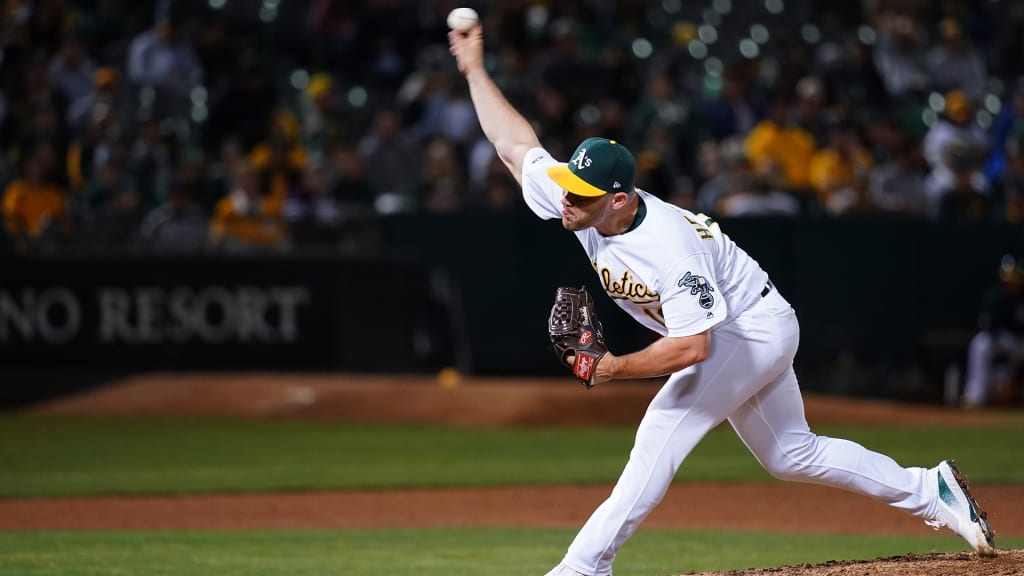
OAKLAND -- There were many different roles A’s manager Bob Melvin envisioned for Liam Hendriks entering the season. It was the role nobody expected where he ultimately thrived.
In a year where the A’s bullpen led the Majors with 30 blown saves as it struggled to hold late leads, Hendriks brought some much-needed stability to the ninth inning. The 30-year-old right-hander enjoyed the most successful season of his career, leading all big league relievers with a 3.8 WAR.
The superb 2019 campaign turned in by Hendriks -- which included 25 saves and a franchise record for strikeouts by a reliever with 124 -- helped mitigate the regression of once-dominant closer Blake Treinen, who lost the closer job in June before finishing the season with a 4.91 ERA.
The journey to success for Hendriks really has been a Cinderella story. It wasn’t too long ago he was designated for assignment by this very A’s organization. That career lowlight came on June 25, 2018, after his ERA had ballooned to 7.36. After going unclaimed, Hendriks went to Triple-A and soon increased his fastball velocity to near-triple digits thanks to a change in diet and implementation of daily long toss. Almost an exact year later, Hendriks transformed from unwanted to elite, taking over as the A’s closer on June 22 and never looking back.
Hendriks earned American League Reliever of the Month honors for June as he compiled a 0.60 ERA with 22 strikeouts in 15 innings. The next month brought even more accolades as he was rewarded with his first career All-Star selection. Finishing 2019 with a 1.80 ERA over 75 games, Hendriks won’t have to worry about getting his contract renewed entering Spring Training. He’s now one of the A’s most important pieces after helping them reach the postseason for a second consecutive season.
“He meant so much to this team this year,” Melvin said. “The acceleration from his role, where he was last year to this year, has just been amazing.”
What went right?
Can one dominant reliever really make that much of a difference? In this case, absolutely. The A’s were 42-37 at the time Hendriks took over as closer. They closed out the season going 56-28 the rest of the way. Over that time, Hendriks’ 25 saves led the Majors as he brought consistency to a section of the club that was erratic for the first three months of the season.
Avoiding free passes was a big factor in the rise of Hendriks. His 0.84 walks-per-nine innings rate was lowest among AL relievers since taking over as closer, issuing just four walks over 42 2/3 innings.
What went wrong?
While no closer was more prolific than Hendriks since June 22, he wasn’t immune to the occasional hiccup. Hendriks also led the Majors with six blown saves in that time, though most of those could have been a product of what A’s manager Bob Melvin described as “overuse” of Hendriks at times down the stretch due to being one of just a few reliable arms. The right-hander was often asked to complete multi-inning saves or pitch three days in a row.
Best moment?
Hendriks had a stretch that was about as dominant as any pitcher this season when he tossed 20 2/3 scoreless innings from June 6-July 20. He struck out 34 batters and converted eight saves over that stretch, and the streak was the longest in the Majors at the time -- it was snapped on July 21 against the Twins.
2020 Outlook
You don’t have to look much farther than Treinen to get a gauge of the volatility that can come with the closer role, but Hendriks will enter next season with a pretty strong hold on that job. The only relievers added by the A’s from the outside would only likely be to provide a stable bridge to Hendriks in the ninth.
As for any potential regression, Hendriks is going to keep his arm as sharp as possible in the offseason in an effort to avoid any rust heading into Spring Training.
“I usually take a week or two off from throwing and then get straight back into it. I don’t want to have that rest period where everything starts hurting,” Hendriks said. “My biggest tendency is to go too hard too soon, so if I don’t stop, there’s no worry about doing that. It’s just a maintenance period.”
